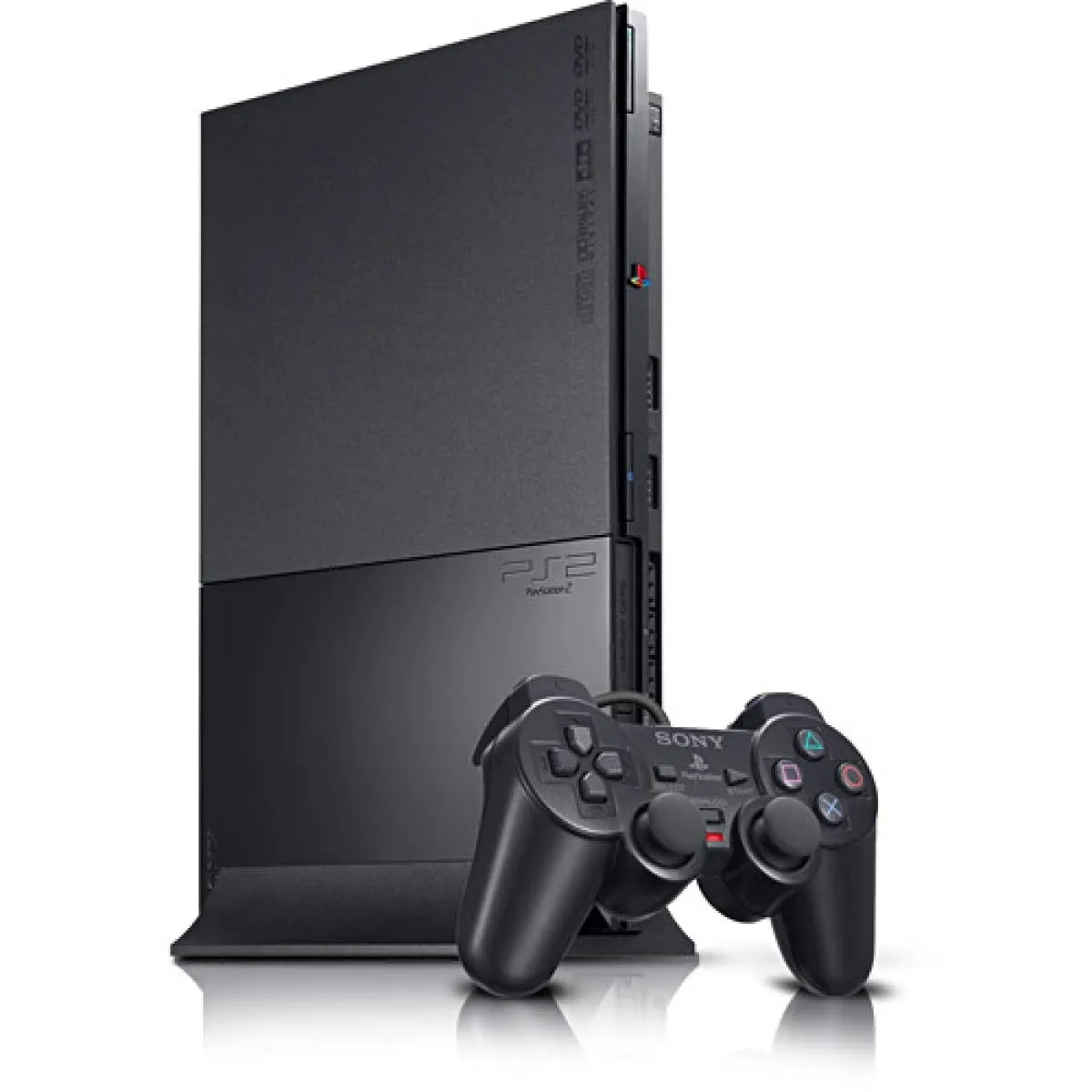
Ah, the PlayStation 2. This classic gaming console has been around since 2000 and is still beloved by gamers today, thanks to its powerful graphics and expansive library of games.
Over the years, the PlayStation 2 has seen several iterations, with some minor changes in design. If you’re thinking of getting a PS2 but aren’t sure which one to buy, this article will help you out.
The main difference between fat and slim PS 2 is their sizes. Fat Playstation 2 is a heavier, box-shaped design while the slim PlayStation 2 is slim and sleek, with a flatter design.
We’ll be exploring the differences between the original fat PlayStation 2 and its slim successor, going over everything from differences in size, power consumption, built-in features, and more.
No matter what your gaming needs are, you can rest assured that there’s a PlayStation 2 out there to fit them—all you have to do is figure out which one is right for you. So, let’s get started!
Coming To Know The PlayStation 2
Released in 2000, the PlayStation 2 has been an entertaining and popular gaming system ever since.
But if you’re looking to get your hands on one now, you have a choice between the classic “Fat” version and its streamlined successor “Slim”.
So what’s the difference?
Well, aesthetics are an obvious factor: the Fat is more of a box/cube shape and it has more ports than the Slim, which has a slimmer design with sleeker edges and fewer ports.
Port selection is important for game consoles, higher end TVs require certain connections for better graphics, so you’ll want to check which ports your TV supports and get the console that matches up.
The Slim also offers some internal upgrades with different motherboards, improved cooling systems, and graphics output. The Slim also looks better on your TV stand or shelf with its compact design.
Whichever console you choose, however, you won’t be disappointed as both deliver amazing performance when it comes to gaming.
Overview Of The Fat And Slim Versions
Are you wondering what the difference is between a fat and a slim PlayStation 2? The answer is quite simple: size.
| Feature | PlayStation 2 Fat | PlayStation 2 Slim |
|---|---|---|
| Dimensions | 301 x 178 x 78 mm | 230 x 28 x 152 mm |
| Weight | 2.1 kg | 0.9 kg |
| Appearance | Large and bulky | Sleek and compact |
| Power Consumption | High | Lower |
| Built-in Ethernet | Optional | Standard |
| USB Ports | 2 | 2 |
| Network Adapter | Separate add-on | Built-in |
| Backward Compatibility | Yes | Yes |
| Internal Storage | 40 GB, 80 GB, 160 GB | None |
| Disc Drive | DVD/CD | DVD/CD |
| Price | Cheaper | More expensive |
The PlayStation 2 Fat and Slim are two different versions of the popular gaming console. The Fat version is larger and bulkier, while the Slim version is sleeker and more compact.
In addition to their appearance, there are a few other differences between the two.
The Slim version has a lower power consumption and comes with a built-in Ethernet port, whereas the Fat version requires a separate add-on for Ethernet connectivity.
The Slim also has a smaller internal hard drive and is more expensive than the Fat version.
Both versions of the PlayStation 2 are backward compatible, meaning that they can play games from the original PlayStation console. They also both have a DVD/CD drive and two USB ports.
The original PlayStation 2 the “fat” version was the first console released by Sony and is approximately 10 inches long, 8 inches wide, and 3 inches thick.
Whereas, the “slim” version was released years later with a new and improved design, making it more energy-efficient than its predecessor while still maintaining the same gaming capabilities.
The slim model is much smaller, measuring 8 inches in length, 7 inches in width, and 2 inches in thickness.
The PlayStation 2 Slim also has two built-in USB ports for use with external devices, such as a memory card adapter or keyboard controller.
In addition, it has updated tray designs that allow for easier loading of games on top of a front-slot loading mechanism; this makes the disk insertion process faster.
While the fat model has one disk-reading laser to read disks, the slim version features two lasers for added accuracy.
Differences in Design & Hardware Specifications
What about the difference between the hardware and design of the fat and slim versions?
Well, there are a few key differences in design and hardware specifications that you should know about. Let’s take a look:
Design
The first thing you’ll notice when comparing the two is their size the slim PS2 is noticeably smaller than the fat one.
The slim model also has silver plates on its sides, which give it a sleek and modern look. The fat model, on the other hand, comes in black plastic and has more of an old-school vibe.
Hardware Specifications
The fat PlayStation 2 has 128 MB of RAM, while the slim version has half of that 64 MB.
Additionally, the slim model supports an ethernet port while the fat one doesn’t have this feature.
And last but not least, there are differences in power outputs—the fat version has output plugs for both S-Video and RCA/composite cables while the slim only supports RCA/composite cables.
So there you have it — now you know exactly what sets these two consoles apart!
What Games Are Compatible With Both?
You might be wondering what games are compatible with both the slim and fat versions of the PlayStation 2.
The answer is that all games released in North America after 2004 are playable on both versions, depending on the game’s region settings.
The important thing to remember is that older model, or “fat” PlayStation 2 games won’t work on a slim model and vice versa, so make sure you’re getting a game for the right console.
Also, keep in mind that certain PS2 accessories won’t be compatible across different versions – like some memory cards, controllers, and hard drives.
So if you’re looking to buy specific hardware for your console, make sure it’s the right version!
Pros & Cons of Each Version
When trying to decide between a fat or slim PlayStation 2, it’s important to know the pros and cons of each version. Let’s take a look:
Fat PlayStation 2

The fat version is the original model and many people prefer it for its nostalgic value.
Plus, you can use a larger variety of accessories with this version, things like memory cards, adaptors, and cool little add-ons like guitars and drums that let you play Guitar Hero.
However, they are more difficult to find now as they have been discontinued.
Slim PlayStation 2

The slim version is much smaller than the fat version because it has a much more efficient cooling system so it takes up less space in your living room.
It also has a built-in Ethernet port so you can connect to your home network and access multiplayer gaming.
On the downside, some accessories that were compatible with the fat versions don’t work as well with this one, they may not fit into the ports or they’ll require an extra adaptor.
How to Purchase A PlayStation 2
If you’re in the market for a PlayStation 2, you may have noticed that there are ‘fat’ and ‘slim’ models available. So what’s the physical difference between them and how do you describe it to the salesman?
Well, let’s start off with the basics: both models have the same basic components and are compatible with all PS2 games.
They use a 128-bit processor, have a maximum of 48MB of system RAM, and a GPU capable of displaying up to 3.2 million polygons per second. In terms of gameplay, they feel basically the same.
That being said, there are some key differences between them:
- The fat model has more internal memory than the slim at 8MB compared to 32MB. This might mean slower load times on certain games if you opt for a slim model.
- The slim model has two USB ports compared to one the fat model which can be useful for connecting extra controllers or gaming accessories.
- The slim model also weighs significantly less than the fat one, at around 2kg compared to 4kg. This makes it easier to transport from one place to another if needed.
- Slim models may come with an integrated Ethernet port which is not found on fat models this is useful if you want to use online multiplayer gaming or want access to streaming services such as Netflix or YouTube.
So depending on your needs, either version of the PlayStation 2 can provide an enjoyable gaming experience, just make sure you weigh up all of your options before making a final purchase.
FAQs
Is the size difference between the fat and slim Playstation 2 important?
Yes! The fat model is significantly larger and heavier, which makes it more difficult to move around or store. The slim PlayStation 2 also had an aesthetic upgrade, making it look smoother and more stylish.
Does the slim version have better performance?
The slim version of PlayStation 2 has improved memory efficiency and fewer hardware problems due to its change in design. This means that the games can load faster and smoother, giving you a better gaming experience overall.
Will my old games still work on the slim model?
Yes, all of your old disk-based games will still work on the PlayStation 2 Slim. However, if you have any old memory cards that are larger than 8MB, then those won’t be compatible with the newer version of PlayStation 2 as it only supports 8MB memory cards.
Conclusion
- To sum it up, the differences between a fat and a slim PlayStation 2 are quite substantial. The fat model is bulky, takes more power to run, and is much louder when it’s running.
- This makes it a less desirable option for most, but it remains a viable option for those who prefer physical media over digital. On the other hand, the slim model is more compact, quieter, and much more energy efficient.
- The slim version comes with a built-in Ethernet port and is the better choice for those who prefer having the ability to connect to the internet and access digital downloads.
- Ultimately, the decision of which model to purchase depends on the individual’s wants and needs.

